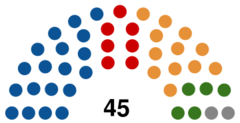Difference between revisions of "National Assembly of Capinderland"
| Line 47: | Line 47: | ||
The Assembly was created in 1944 after the a [[Capindi Civil War|revolution]], and the first election happened the same year. The have been many moves to add a second, upper chamber, to further regulate and check bills. Most notable leaders of these ideas are incumbent President [[Jöran Whittle]] and the rest of the [[Liberal Democrats of Capinderland|Liberal Democrats]]. | The Assembly was created in 1944 after the a [[Capindi Civil War|revolution]], and the first election happened the same year. The have been many moves to add a second, upper chamber, to further regulate and check bills. Most notable leaders of these ideas are incumbent President [[Jöran Whittle]] and the rest of the [[Liberal Democrats of Capinderland|Liberal Democrats]]. | ||
| + | ==Title== | ||
| + | The name "National Assembly" was only truly adopted in 1977, after a law confirming the name change. Before then it had no real name, and many different titles were used, such as the General Assembly, Peoples Assembly,and Commons Assembly. The members were just called "Assemblymen" until 1977, where they were official changed to Member National Assembly to match the legislatures new name | ||
| + | ==Members of National Assembly== | ||
| + | The National Assembly is based off the {{wpl|United States House of Representatives}}, using the arch method to sit its MNA's. They were formerly known as "Assemblymen" until 1977, where they were changed to MNA's. They meet in the Assembly Building in [[Makita]]. The seating plan resembles an arch, with the governing party(s) sitting to the speakers right, starting with the largest party the furthest left, then all the coalition parties to the right. The opposition sit on the right, going left to right in amount seats. The debates are presided over by the Speaker of the House. | ||
Revision as of 19:32, 18 May 2016
| The Capindi National Assembly | |
|---|---|
| 17th Assembly | |
 | |
| Leadership | |
| Prime Minister |
Garrett Hillam, LD Since March 3rd 2016 |
| Speaker of the House |
Kae Foss, LD Since March 3rd 2016 |
| Structure | |
| Seats | 45 voting members |
| Political groups |
Goverment (26) Oppisition (19) |
| Elections | |
| Last election | March 3rd 2016 |
The National Assembly of Capinderland is the sole legislative body in The Federal Republic of Capinderland. It along with the executive branch form the law making body for the republic.
The Assembly is a democratically elected body, constiting of 45 members, also known as MNA's (Member of National Parliament). Member's are elected in terms, serving for four years each, until they must be re-elected. The last election was in 2016, where the Liberal Democrats won under a minority government.
The Assembly was created in 1944 after the a revolution, and the first election happened the same year. The have been many moves to add a second, upper chamber, to further regulate and check bills. Most notable leaders of these ideas are incumbent President Jöran Whittle and the rest of the Liberal Democrats.
Title
The name "National Assembly" was only truly adopted in 1977, after a law confirming the name change. Before then it had no real name, and many different titles were used, such as the General Assembly, Peoples Assembly,and Commons Assembly. The members were just called "Assemblymen" until 1977, where they were official changed to Member National Assembly to match the legislatures new name
Members of National Assembly
The National Assembly is based off the United States House of Representatives, using the arch method to sit its MNA's. They were formerly known as "Assemblymen" until 1977, where they were changed to MNA's. They meet in the Assembly Building in Makita. The seating plan resembles an arch, with the governing party(s) sitting to the speakers right, starting with the largest party the furthest left, then all the coalition parties to the right. The opposition sit on the right, going left to right in amount seats. The debates are presided over by the Speaker of the House.
